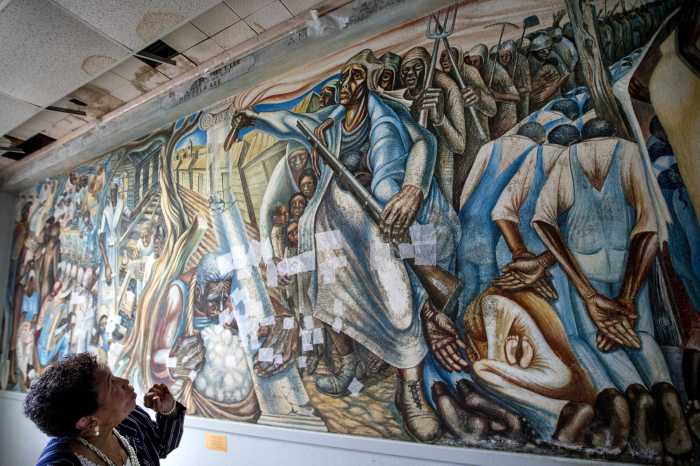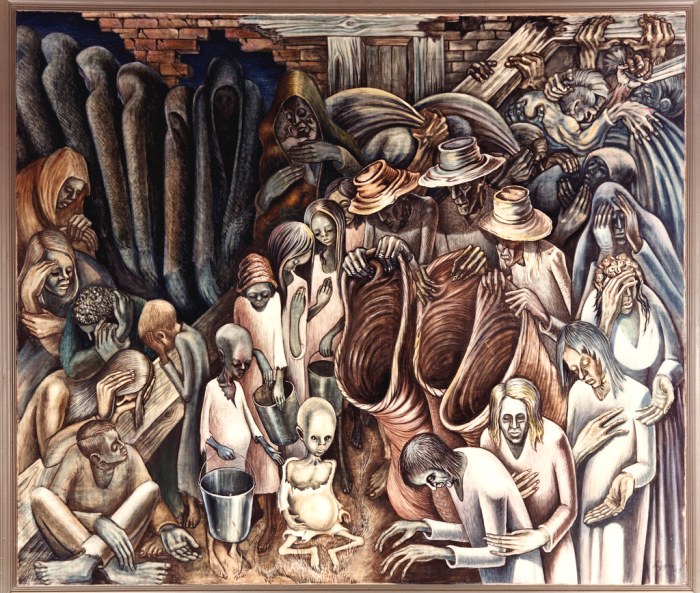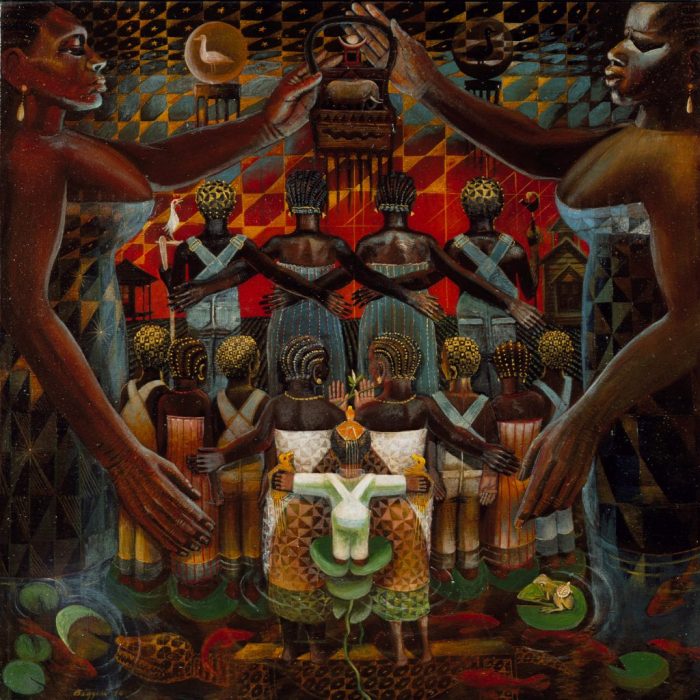John biggers night of the poor – John Biggers’ “Night of the Poor” stands as a powerful testament to the artist’s commitment to social justice and the human condition. Through its evocative imagery and symbolic language, the painting captures the harsh realities of poverty and inequality, inviting viewers to confront these issues and reflect on their profound impact on society.
Biggers’ personal experiences and observations during the Great Depression deeply influenced the creation of this artwork, which showcases his unique style and techniques. The painting’s composition, use of color, and symbolism all contribute to its powerful message, resonating with audiences across generations.
John Biggers’ Life and Career

John Thomas Biggers was an American artist and educator known for his vibrant and evocative paintings depicting the African American experience. His early life and upbringing played a significant role in shaping his artistic vision and subject matter.
Early Life and Upbringing
Biggers was born in Gastonia, North Carolina, in 1924. He grew up in a poor but close-knit family, surrounded by the traditions and culture of the rural South. His parents, sharecroppers, instilled in him a strong work ethic and a deep appreciation for the beauty of their surroundings.
These early experiences left an enduring mark on Biggers, informing the themes of community, resilience, and the struggle for social justice that would later become central to his art.
Education and Artistic Influences
Biggers’ artistic education began at Hampton Institute in Virginia, where he studied under the renowned artist Viktor Lowenfeld. Lowenfeld’s emphasis on experimentation and self-expression had a profound influence on Biggers, who developed a unique style that combined elements of realism, abstraction, and African motifs.
After graduating from Hampton, Biggers continued his studies at the Art Institute of Chicago, where he encountered the work of Mexican muralists such as Diego Rivera and José Clemente Orozco. These artists’ use of public art to address social and political issues further inspired Biggers’ commitment to creating art that reflected the experiences of marginalized communities.
Major Themes and Styles
Throughout his career, Biggers’ work explored the complexities of African American history and culture. His paintings often depicted scenes of everyday life in the South, as well as moments of historical significance. He used vibrant colors, bold forms, and intricate patterns to convey the beauty, resilience, and struggles of his subjects.
Biggers’ art also reflected his interest in African art and culture, which he incorporated into his work through the use of symbols, motifs, and rhythmic compositions.
John Biggers’ Night of the Poor is a powerful depiction of the struggles faced by the poor. If you’re looking for a way to learn more about this topic, I recommend checking out the free penn foster exam answers available online.
They provide a comprehensive overview of the challenges faced by the poor, as well as potential solutions.
“Night of the Poor” Context and Inspiration

John Biggers’s “Night of the Poor” painting reflects the historical and social context of the Great Depression in the United States during the 1930s. The widespread economic crisis led to widespread poverty, homelessness, and unemployment, disproportionately affecting African Americans and other marginalized communities.
Personal Experiences and Observations
Biggers’s own experiences growing up in a poor African American family in Gastonia, North Carolina, shaped his perspective on the plight of the poor. He witnessed firsthand the struggles faced by his family and community during the Depression. These experiences instilled in him a deep empathy for the suffering of others and motivated him to use his art to shed light on social injustices.
Symbolism and Iconography
In “Night of the Poor,” Biggers employs powerful symbolism and iconography to convey the message of poverty and human suffering. The painting depicts a group of poor and homeless people gathered around a fire for warmth and comfort. The fire serves as a symbol of hope and resilience amidst adversity, while the dark and oppressive background represents the harsh realities of life for the poor.
Biggers also incorporates African American cultural symbols into the painting, such as the quilt and the spirituals. The quilt, a traditional symbol of African American community and resilience, provides comfort and warmth to the people gathered around the fire. The spirituals, represented by the musical notes floating in the air, offer a sense of hope and solace in the face of adversity.
Visual Elements and Composition

The “Night of the Poor” painting by John Biggers exhibits a compelling composition and layout that captivates the viewer’s attention. The artwork is characterized by its elongated, horizontal format, which accentuates the vastness and depth of the scene.
Biggers skillfully employs color, light, and perspective to create a powerful and evocative image. The painting is dominated by a somber palette of blues, browns, and grays, which convey a sense of poverty and hardship. The light source emanates from the left side of the canvas, casting dramatic shadows that emphasize the figures and objects in the foreground.
Biggers’ Unique Style and Techniques
Biggers’ unique style and techniques contribute significantly to the painting’s impact. His use of flattened, geometric forms and simplified shapes creates a sense of order and structure amidst the chaos and poverty depicted in the scene. The figures are rendered with elongated, attenuated limbs, which further enhances the sense of vulnerability and suffering.
Biggers’ innovative use of collage and mixed media adds depth and texture to the painting. He incorporates fragments of old newspapers, maps, and other materials into the composition, which enriches the narrative and provides historical context. The collage elements also serve to break up the flatness of the canvas, creating a dynamic and visually engaging surface.
Cultural and Social Significance

John Biggers’ “Night of the Poor” holds immense cultural and social significance within the African American community. It serves as a powerful testament to the struggles and resilience of the Black community in the face of poverty and inequality.
Role in Raising Awareness
The painting played a pivotal role in raising awareness about the pervasive poverty and social inequality experienced by African Americans. Through its depiction of the impoverished conditions and hardships faced by the Black community, it brought these issues to the forefront of public consciousness.
The painting’s widespread recognition and exhibition helped galvanize support for social justice movements and policies aimed at addressing these disparities.
Impact on Subsequent Generations, John biggers night of the poor
The impact of “Night of the Poor” extended beyond its immediate time. It became a source of inspiration and empowerment for subsequent generations of artists and activists. The painting’s powerful imagery and message resonated with young Black artists, encouraging them to use their creativity to address social and political issues.
It also influenced activists, who drew upon its symbolism and message to mobilize for change and advocate for the rights of the marginalized.
Comparisons and Contrasts: John Biggers Night Of The Poor

John Biggers’ artistic journey is evident in the evolution of his themes, styles, and techniques, which can be observed by comparing “Night of the Poor” with his other works.
Themes
- Social Justice:Biggers’ works consistently addressed issues of social injustice, poverty, and the African American experience, as seen in “Night of the Poor” and “The Procession.”
- African American Identity:Biggers explored the cultural heritage and resilience of the African American community, as depicted in “Folk Musicians” and “Harlem Street Scene.”
Styles
- Folk Art Influence:Biggers incorporated elements of African American folk art, such as bold colors, geometric shapes, and symbolic imagery, into works like “Quilt Block” and “Night of the Poor.”
- Abstract Expressionism:In later works, Biggers experimented with abstract expressionist techniques, using fluid brushstrokes and vibrant colors, as in “Flight South” and “Ancestral Legacy.”
Techniques
- Collage:Biggers often used collage to combine various materials, including fabric, paper, and found objects, as seen in “Doorway to the River” and “Patchwork Quilt.”
- Mixed Media:Biggers’ works frequently employed a combination of painting, drawing, and printmaking techniques, as in “The Block” and “Southern Exodus.”
Query Resolution
What is the significance of “Night of the Poor”?
The painting serves as a powerful critique of poverty and inequality, highlighting the struggles faced by the marginalized during the Great Depression.
How did Biggers’ personal experiences influence the creation of the painting?
Biggers’ own experiences with poverty and social injustice during the Great Depression deeply shaped the themes and imagery of “Night of the Poor.”
What is the symbolism used in the painting?
The painting features symbolic elements such as the sleeping figures, the barren landscape, and the muted colors, which convey a sense of despair and hopelessness.